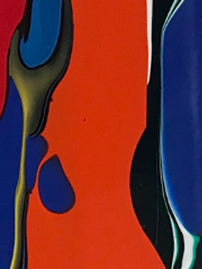Acrylic Gouache BY Simon Willems

One of the primary challenges when using gouache, whether one welcomes this as part of the
working process or not is wrestling with the way in which, like watercolour, the surface opens up
when re-wetted. This lack of stability is characteristic of both mediums.
The gum Arabic binder sourced from Acacia trees in northern Africa and the Middle East as a water-soluble gum and sealant, whilst providing adhesion and film, does not prove water-resistant when dry. So, where the smooth and characteristically matte surface quality of gouache might be desirable, this might be compromised, or at least curtailed, where the paint is reactivated in the building up of layers in
specific scenarios. It might be significant that layers are acknowledged as they work through the surface, where a process of ‘layering’ and working between different passages becomes critical.
Think of how this might play out in an Ian Mckeever, for example, where the overlaying of semitransparent paint applications is what makes the work. But even if this isn’t the case, and the aim
is to achieve a pristine display of intense flat pigment akin to Matisse’s gouaches découpées cutouts, any accidental wetting of the surface could prove disastrous. This, as far as I can see, is what marks out ‘acrylic gouache’ as a painting medium, that like regular acrylics, when the paint is dry, it’s dry, and yet all the signature features of gouache are retained: opacity, matteness, that velvety texture, smooth mixing, and so on. Of course, this shouldn’t be taken as read that gouache and acrylic gouache behave the same way to the letter. It’s more a case by the analogy of thinking about the differences between original colour and its equivalent hue; for example, between how Cobalt blue might behave in its materiality and application when mulling over the options of what Cobalt blue hue brings to the table. Invariably, there are pros and cons to any ‘original’ colour painting choice and the reformulations of that colour. However, what gouache provides and this remains constant with acrylic gouache is dense concentrations of pigment.
There is a much higher ratio of colour pigment contained within gouache, in that sense, than there is in watercolour, which, coupled with its silky matte finish, lends gouache a particular intensity and vibrancy of colour. This is what particularly appeals to the new range of acrylic gouaches that Liquitex launched in 2018, that they are ultra-pigmented, even beyond the density of pigment in gouache that one normally finds elsewhere. But it is not only the concentration of colour on a show that stands out, it’s the range. There are, of course, the ‘cadmium-free’ options running through the series from ‘Cadmium-free Yellow Light’ to ‘Cadmium-free Red Deep’, which is a real move forward given the ban on cadmium that has kicked in in recent years, but the real jewel in the crown, for me at least, is the range of fluorescents. Featuring six colours in total, including ‘Flourescent Violet’ and ‘Flourescent Opera Pink’, I wasn’t aware of their superior quality until my studio-mate, who works with fluorescent colour (and red in particular) showed me a swatch of different reds she was considering for a painting, where the Liquitex acrylic gouache stood out significantly against the rest.

